5G Internet of Things (IoT) Market Size
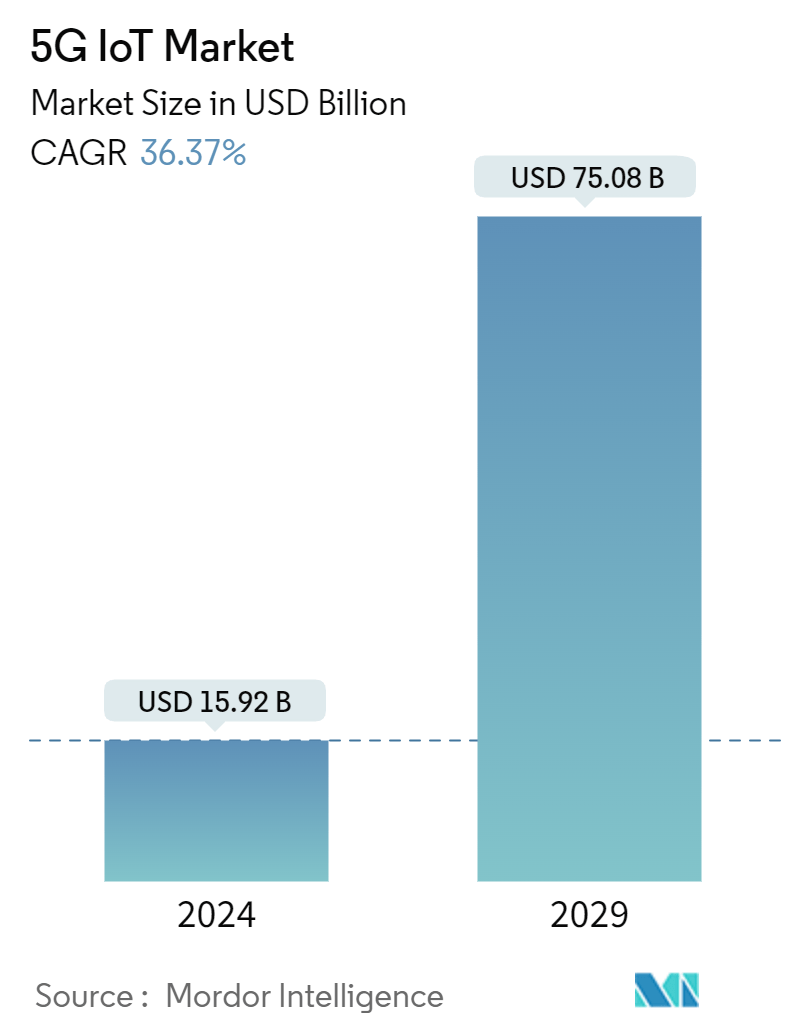
| Study Period | 2019 - 2029 |
| Market Size (2024) | USD 15.92 Billion |
| Market Size (2029) | USD 75.08 Billion |
| CAGR (2024 - 2029) | 36.37 % |
| Fastest Growing Market | Asia Pacific |
| Largest Market | North America |
Major Players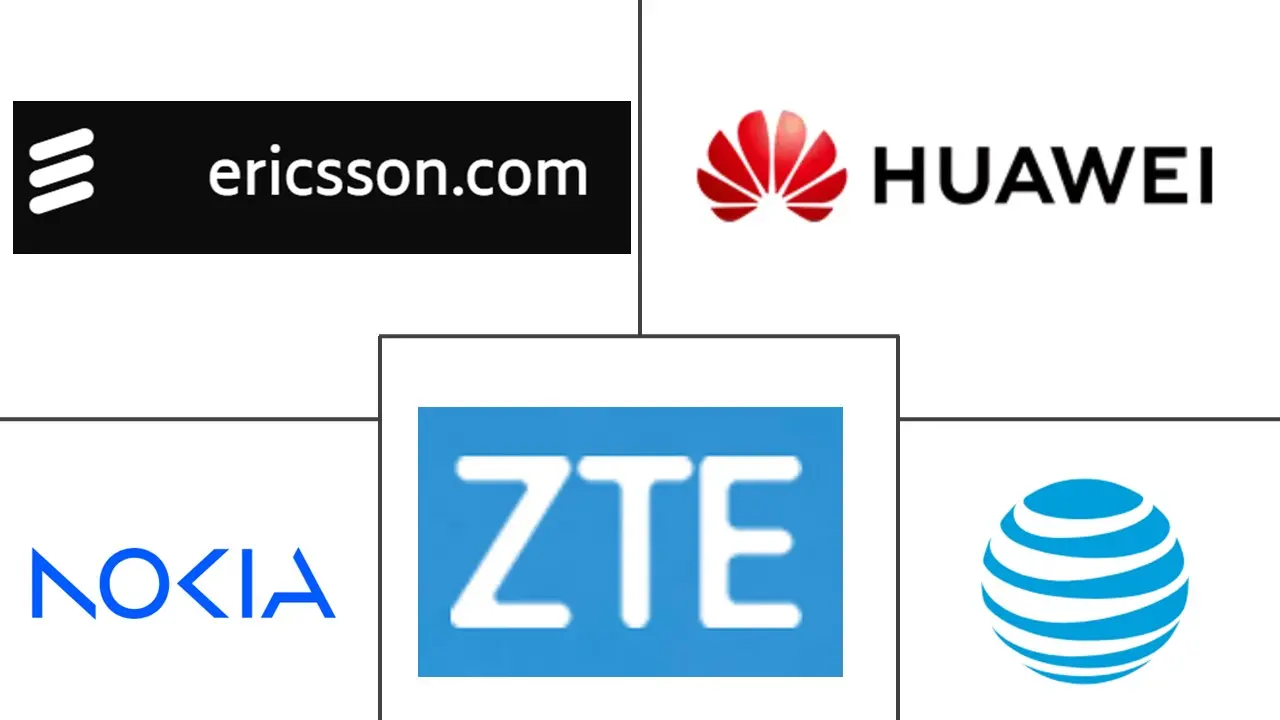
*Disclaimer: Major Players sorted in no particular order |
5G Internet of Things (IoT) Market Analysis
The 5G IoT Market size is estimated at USD 15.92 billion in 2024, and is expected to reach USD 75.08 billion by 2029, growing at a CAGR of 36.37% during the forecast period (2024-2029).
The 5G IoT market is poised to revolutionize how connected devices interact across various industries, leveraging the high-speed, low-latency capabilities of 5G networks. This technology enables a new level of connectivity for the Internet of Things (IoT), facilitating seamless communication between millions of devices. The integration of 5G into IoT networks is driving significant advancements in industries such as manufacturing, healthcare, and smart cities, where real-time data exchange and ultra-reliable communications are crucial.
- With 5G IoT technology, industries are witnessing an evolution in how data is collected, analyzed, and utilized, leading to enhanced operational efficiencies and the creation of innovative solutions. The market's growth is underpinned by the advantages 5G offers over existing LTE networks, including reduced latency, higher data throughput, and the capacity to connect a vast number of IoT devices simultaneously. However, the transition to 5G also comes with challenges, particularly the need for substantial infrastructure upgrades and the ongoing relevance of 4G LTE for certain IoT use cases.
Enhanced Connectivity: A Game-Changer for IoT Networks
- Unprecedented Device Handling Capabilities: The ability of 5G IoT technology to support a massive number of IoT devices is one of its most significant strengths. In industries like smart cities and manufacturing, the sheer volume of connected devices necessitates a network that can manage and maintain reliable connections across all devices. 5G IoT networks excel in this aspect, enabling real-time data exchange that is essential for automated processes, smart infrastructure, and large-scale IoT ecosystems. This capability significantly enhances industry operations, driving greater efficiency and opening new avenues for IoT applications that were previously unattainable with older network technologies.
- Low Latency and Critical Application Support: The low latency provided by 5G IoT networks is pivotal for applications requiring instantaneous data transmission. In healthcare, for example, 5G IoT devices facilitate real-time monitoring and remote surgeries, where any delay could be critical. Similarly, in the automotive industry, 5G supports the development of autonomous vehicles, where split-second decisions are necessary for safety. These critical applications highlight the transformative impact of 5G IoT solutions, as they enable new use cases that demand ultra-reliable and low-latency communication, which 4G LTE cannot adequately support.
Infrastructure Challenges: Balancing Cost and Innovation
- Existing 4G LTE Sufficiency for Certain Use Cases: While 5G IoT technology offers significant benefits, there are scenarios where existing 4G LTE networks are still sufficient, particularly for less demanding IoT applications. Some industries may find that the current 4G infrastructure meets their needs without requiring the expensive transition to 5G. This is especially true for use cases where low bandwidth and lower device density are acceptable, such as in basic monitoring systems or non-critical data collection scenarios. The sufficiency of 4G LTE in these contexts can slow the adoption of 5G, as companies weigh the costs and benefits of upgrading.
- High Costs of Infrastructure Upgrades: The transition from LTE to 5G involves considerable investment, particularly in upgrading the existing infrastructure. The costs associated with deploying 5G networks, including the installation of new antennas, network configurations, and the procurement of 5G-enabled devices, are substantial. This financial burden can be a significant barrier for industries looking to adopt 5G IoT solutions, especially in regions where 4G infrastructure is still relatively new. Companies must balance the long-term benefits of 5G IoT adoption with the immediate financial outlay, which may delay widespread implementation.
The 5G IoT market is at a critical juncture where the potential for groundbreaking advancements is tempered by the practical challenges of infrastructure development and cost considerations. As industries continue to explore the full capabilities of 5G IoT networks, the balance between innovation and cost will play a crucial role in shaping the market's future trajectory.
5G Internet of Things (IoT) Market Trends
Automotive Industry is Expected to Witness Significant Growth Rate
- Rapid Evolution of Connected Vehicles: The automotive industry is undergoing a major transformation, driven by the integration of 5G IoT technology. With ultra-low latency and high-speed data transfer, 5G IoT is crucial for enabling advanced features like vehicle-to-everything (V2X) communication, autonomous driving, and real-time data processing. This technological shift is expected to significantly boost market growth as automakers leverage 5G IoT networks to enhance vehicle safety, efficiency, and overall user experience.
- Expansion of the 5G IoT Ecosystem: The 5G IoT ecosystem within the automotive sector is rapidly expanding, with new use cases such as remote diagnostics, predictive maintenance, and enhanced in-car entertainment systems. These innovations not only improve driving experiences but also offer new revenue streams for manufacturers and service providers. As connected vehicles become more prevalent, the automotive industry is set to be a key driver of growth within the 5G IoT market, significantly contributing to its overall market size.
- Investment Surge in 5G IoT Infrastructure: Major players in the automotive industry are making significant investments in 5G IoT infrastructure to capitalize on emerging opportunities. These investments are aimed at supporting the development of autonomous vehicles, which require reliable, real-time communication with other connected devices. As a result, the automotive segment is expected to experience a compound annual growth rate (CAGR) that outpaces other sectors within the 5G IoT market, further fueled by smart city initiatives and the growing demand for connected vehicle solutions.
- Autonomous Driving and Market Predictions: The ongoing advancements in autonomous driving technology, supported by 5G IoT, are expected to reshape the automotive landscape. Industry reports indicate that the automotive segment will witness robust growth, driven by the integration of 5G IoT solutions in smart cities. Connected vehicles will interact with smart infrastructure to optimize traffic flow, reduce emissions, and enhance public safety, positioning the automotive industry as a major contributor to the overall growth of the 5G IoT market.
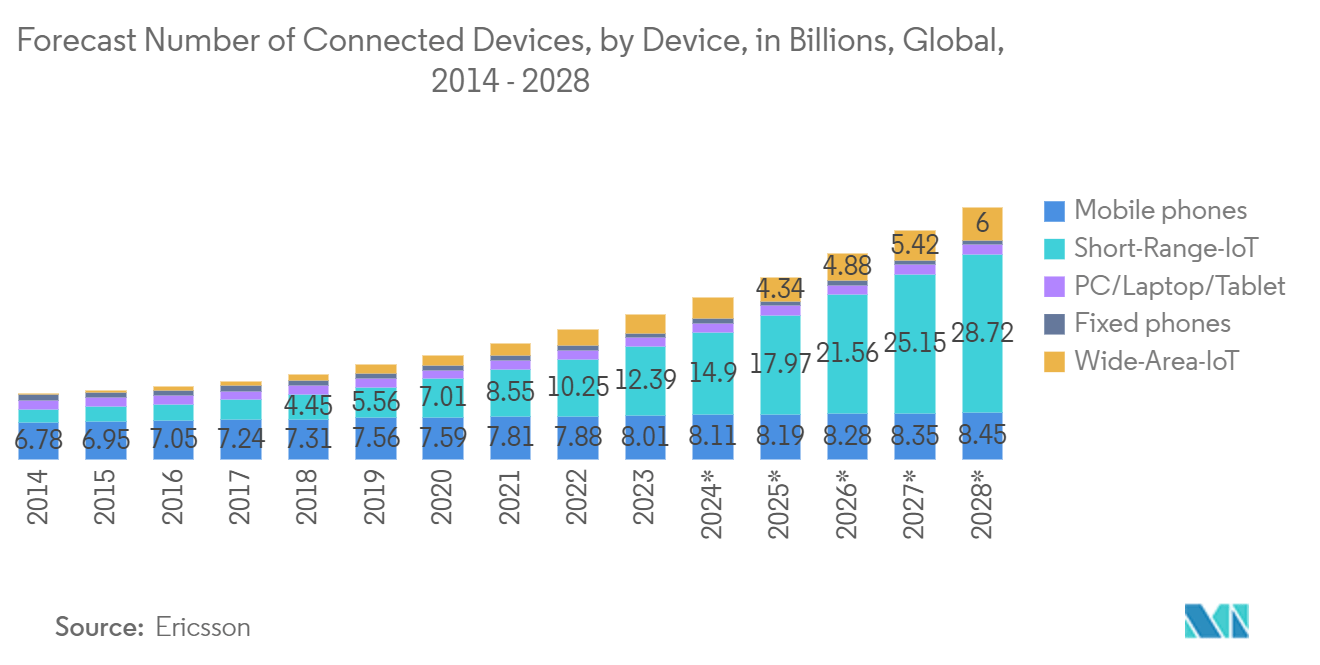
North America is Expected to Hold Significant Market Share
- Early Adoption and Market Leadership: North America is poised to maintain its dominant position in the global 5G IoT market, thanks to its early adoption of 5G technology and substantial investments in IoT infrastructure. The region's strong technological foundation and presence of leading market players have established it as a critical player in the global 5G IoT ecosystem. This leadership is expected to continue, supported by favorable regulatory environments and ongoing advancements in 5G IoT solutions.
- Widespread Implementation Across Industries: The rapid deployment of 5G IoT applications across various sectors, including healthcare, manufacturing, and logistics, is a key factor driving North America's market dominance. These industries are utilizing 5G IoT technology to enhance operational efficiency, reduce costs, and improve service delivery. For example, in healthcare, 5G IoT enables remote patient monitoring, telemedicine, and smart medical devices, which are essential for improving patient outcomes and easing the burden on healthcare systems.
- Focus on Cybersecurity and Data Privacy: North America's strong emphasis on cybersecurity and data privacy is driving the adoption of secure 5G IoT networks. Ensuring the protection of connected devices and networks from potential threats is crucial for building consumer and business trust in 5G IoT technology. This focus on security is a key factor in sustaining North America's leadership in the global market, as the region continues to expand its 5G IoT ecosystem while prioritizing data protection.
- Continuous Growth and Innovation: Market forecast data suggests that North America's 5G IoT market will continue to grow, driven by technological advancements and increasing investments in research and development. The region's commitment to innovation is evident in various industry research initiatives and partnerships aimed at exploring new 5G IoT use cases. As a result, North America's market outlook remains positive, with the region expected to maintain a substantial share of the global 5G IoT industry in the coming years, further solidifying its position as a market leader.
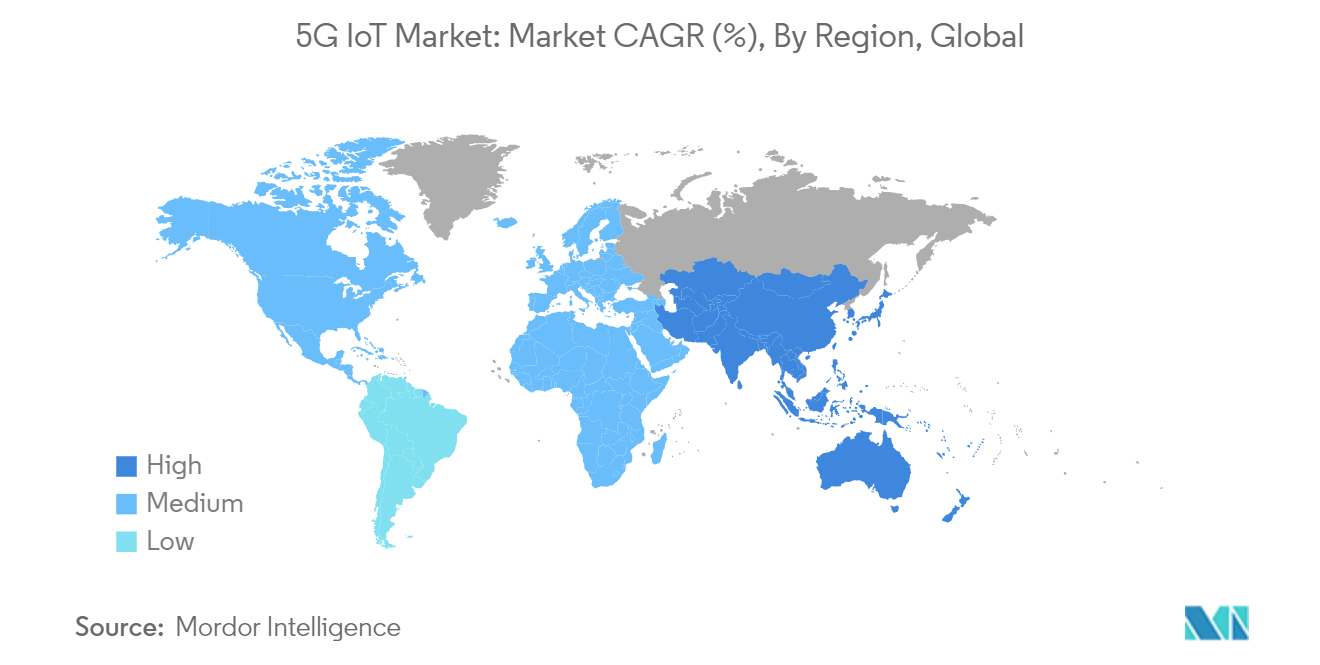
5G Internet of Things (IoT) Industry Overview
Highly Fragmented Market: The 5G IoT market is characterized by a high level of fragmentation, with a diverse array of global and regional players competing for market share. The market is driven by both large conglomerates and specialized companies, each bringing unique strengths and technologies to the table. This fragmentation suggests a competitive environment where no single company dominates, allowing multiple players to coexist and innovate across different sectors. The 5G IoT market's fragmented nature fosters a dynamic ecosystem, with opportunities for both established and emerging companies to succeed.
Major Players Include Global Telecom Giants: In the 5G IoT market, leading companies include Nokia Corporation, AT&T Inc., Huawei Technologies Co Ltd, Telefonaktiebolaget LM Ericsson, and ZTE Corporation. These companies are recognized for their extensive experience in telecommunications and their ability to leverage existing infrastructure to support 5G IoT applications. Their global reach, technological expertise, and strong financial backing provide them with significant advantages in the market. These companies are often involved in strategic partnerships, mergers, and acquisitions to expand their market presence and enhance their IoT solutions.
Key Factors for Future Success: For companies in the 5G IoT market, success will depend on their ability to innovate, form strategic alliances, and maintain strong network infrastructure. The rapid evolution of 5G technology and IoT applications requires companies to continuously adapt and improve their offerings. Factors such as network security, scalability, and interoperability will be critical in differentiating successful players from their competitors. Additionally, companies that can offer integrated solutions and services across various industries, such as healthcare, automotive, and smart cities, will be well-positioned for long-term success.
5G Internet of Things (IoT) Market Leaders
-
Nokia Corporation
-
AT&T Inc.
-
Huawei Technologies Co Ltd
-
Telefonaktiebolaget LM Ericsson
-
ZTE Corporation
*Disclaimer: Major Players sorted in no particular order
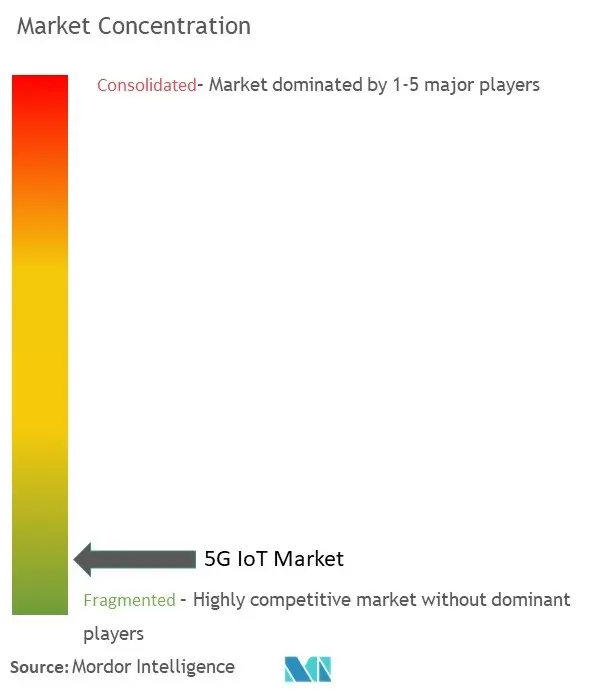
5G Internet of Things (IoT) Market News
- July 2024 - Three leading telecom operators from Korea - SK Telecom, KT, and LG Uplus - have teamed up with the Radio Promotion Association of Korea (RAPA). Their goal is to bolster small and medium-sized enterprises (SMEs) by disseminating vital 5G IoT-related technical specifications. This initiative seeks to empower SMEs, equipping them to develop 5G IoT products that effortlessly connect with telecommunication networks.
- July 2024 - Ericsson, in collaboration with e& United Arab Emirates (UAE), has successfully validated the Reduced Capability (RedCap) software solution on e&'s 5G Standalone (5G SA) network. This achievement signifies the debut of Ericsson's RedCap solution in a commercial network within the Middle East and Africa region (MEA). RedCap empowers 5G IoT devices, including wearables and industrial sensors, to function with diminished complexity and size. This advancement boosts cost efficiency and battery longevity, all while ensuring adequate data speeds.
- March 2024 - Nokia has entered into a strategic partnership with Sterlite Technologies (STL) to reshape networking and digital solutions for government institutions and enterprises. Their primary focus is on projects driven by government connectivity initiatives. This collaboration is poised to accelerate the Industry 4.0 revolution, empowering businesses with a competitive advantage through cutting-edge technologies. The Nokia-STL alliance is dedicated to enhancing enterprise networks, guaranteeing swift, reliable, and low-latency connections. These enhancements cater to 5G, IoT, data center interconnectivity, supply chain optimization, real-time data analytics, and generative AI applications.
- February 2024 - In a strategic move, US operator Verizon has joined forces with Japan's KDDI to provide connectivity in North America for an upcoming electric vehicle from Sony Honda Mobility (SHM), a joint venture between Sony and Honda. Under this collaboration, Verizon is set to provide cellular IoT and broadband connectivity for SHM's newly launched AFEELA line of electric vehicles.
5G Internet of Things (IoT) Market Report - Table of Contents
1. INTRODUCTION
- 1.1 Study Assumptions and Market Definition
- 1.2 Scope of the Study
2. RESEARCH METHODOLOGY
3. EXECUTIVE SUMMARY
4. MARKET INSIGHTS
- 4.1 Market Overview
-
4.2 Industry Attractiveness - Porter's Five Forces Analysis
- 4.2.1 Bargaining Power of Suppliers
- 4.2.2 Bargaining Power of Buyers/Consumers
- 4.2.3 Threat of New Entrants
- 4.2.4 Threat of Substitute Products
- 4.2.5 Intensity of Competitive Rivalry
- 4.3 Technology Snapshot
5. MARKET DYNAMICS
-
5.1 Market Drivers
- 5.1.1 The Ability of 5G Technology to Handle Millions of IoT Connected Devices
- 5.1.2 Advantages of 5G over LTE for Low Latency and Critical Applications
-
5.2 Market Restraints
- 5.2.1 Existing 4G LTE Technology is Sufficient for Certain IoT Use Cases
- 5.2.2 Costs Involved in the up-gradation of the Infrastructure from LTE to 5G
6. MARKET SEGMENTATION
-
6.1 By Technology
- 6.1.1 Ultra-Reliable Low-Latency Communications (URLLC)
- 6.1.2 Low-Power Wide-Area Network (LPWAN)
-
6.2 By End-User Industry
- 6.2.1 Manufacturing
- 6.2.2 Supply Chain
- 6.2.3 Healthcare
- 6.2.4 Retail
- 6.2.5 Smart Cities
- 6.2.6 Automotive
-
6.3 By Geography***
- 6.3.1 North America
- 6.3.1.1 United States
- 6.3.1.2 Canada
- 6.3.1.3 Mexico
- 6.3.2 Europe
- 6.3.2.1 Germany
- 6.3.2.2 United Kingdom
- 6.3.2.3 France
- 6.3.2.4 Russia
- 6.3.2.5 Spain
- 6.3.3 Asia
- 6.3.3.1 India
- 6.3.3.2 China
- 6.3.3.3 Japan
- 6.3.4 Australia and New Zealand
- 6.3.5 South America
- 6.3.5.1 Brazil
- 6.3.5.2 Argentina
- 6.3.6 Middle East and Africa
- 6.3.6.1 United Arab Emirates
- 6.3.6.2 Saudi Arabia
- 6.3.6.3 Africa
7. COMPETITIVE LANDSCAPE
-
7.1 Company Profiles*
- 7.1.1 Nokia Corporation
- 7.1.2 AT&T Inc.
- 7.1.3 Huawei Technologies Co Ltd
- 7.1.4 Telefonaktiebolaget LM Ericsson
- 7.1.5 ZTE Corporation
- 7.1.6 Cisco Systems Inc
- 7.1.7 Deutsche Telekom AG (T-Mobile)
- 7.1.8 Verizon Communication Inc
- 7.1.9 Sprint Corp
- 7.1.10 Vodafone Group PLC
8. MARKET OPPORTUNITIES AND FUTURE TRENDS
** Subject To Availablity5G Internet of Things (IoT) Industry Segmentation
The 5G IoT market involves developing, producing, and implementing 5G-enabled IoT devices, sensors, and modules that communicate seamlessly over 5G networks. These devices can range from smart home appliances and wearable gadgets to industrial sensors, connected vehicles, and infrastructure components.
The 5G IoT Market is segmented by technology (ultra-reliable low-latency communications (URLLC), low-power wide-area network (LPWAN), by end-user industry (manufacturing, supply chain, healthcare, retail, smart cities, automotive), by geography (North America (United States, Canada, Mexico, rest of North America), Europe (Germany, United Kingdom, France, Russia, Spain, rest of Europe), Asia Pacific (India, China, Japan, rest of Asia Pacific), South America (Brazil, Argentina, rest of South America), Middle East and Africa (UAE, Saudi Arabia, Africa).
The market sizes and forecasts are provided in terms of value in USD for all the above segments.
| By Technology | Ultra-Reliable Low-Latency Communications (URLLC) | |
| Low-Power Wide-Area Network (LPWAN) | ||
| By End-User Industry | Manufacturing | |
| Supply Chain | ||
| Healthcare | ||
| Retail | ||
| Smart Cities | ||
| Automotive | ||
| By Geography*** | North America | United States |
| Canada | ||
| Mexico | ||
| By Geography*** | Europe | Germany |
| United Kingdom | ||
| France | ||
| Russia | ||
| Spain | ||
| By Geography*** | Asia | India |
| China | ||
| Japan | ||
| By Geography*** | Australia and New Zealand | |
| South America | Brazil | |
| Argentina | ||
| Middle East and Africa | United Arab Emirates | |
| Saudi Arabia | ||
| Africa |
5G Internet of Things (IoT) Market Research FAQs
How big is the 5G IoT Market?
The 5G IoT Market size is expected to reach USD 15.92 billion in 2024 and grow at a CAGR of 36.37% to reach USD 75.08 billion by 2029.
What is the current 5G IoT Market size?
In 2024, the 5G IoT Market size is expected to reach USD 15.92 billion.
Who are the key players in 5G IoT Market?
Nokia Corporation, AT&T Inc., Huawei Technologies Co Ltd, Telefonaktiebolaget LM Ericsson and ZTE Corporation are the major companies operating in the 5G IoT Market.
Which is the fastest growing region in 5G IoT Market?
Asia Pacific is estimated to grow at the highest CAGR over the forecast period (2024-2029).
Which region has the biggest share in 5G IoT Market?
In 2024, the North America accounts for the largest market share in 5G IoT Market.
What years does this 5G IoT Market cover, and what was the market size in 2023?
In 2023, the 5G IoT Market size was estimated at USD 10.13 billion. The report covers the 5G IoT Market historical market size for years: 2019, 2020, 2021, 2022 and 2023. The report also forecasts the 5G IoT Market size for years: 2024, 2025, 2026, 2027, 2028 and 2029.
5G IoT Industry Report
Our in-depth industry research on the 5G IoT market offers a comprehensive analysis of the latest trends, growth drivers, and challenges shaping this rapidly evolving sector. The report delves into the transformative impact of 5G IoT technology on various industries, highlighting key advancements in 5G IoT applications, network infrastructure, and security measures. By exploring the integration of 5G IoT devices across sectors such as healthcare, automotive, and smart cities, stakeholders gain valuable insights into the opportunities and challenges posed by this technology. The industry report provides critical data and forecasts, ensuring stakeholders are equipped with the necessary information to navigate the 5G IoT ecosystem effectively.
Stakeholders will benefit from our detailed analysis of market data, including industry size, trends, and forecasts, all consolidated into an easy-to-read report pdf format. The report covers essential aspects such as 5G IoT innovations, adoption rates, and infrastructure developments, enabling businesses to make informed decisions. With a focus on actionable insights, the industry report is an indispensable resource for companies seeking to stay ahead in the competitive 5G IoT market, providing a clear understanding of the industry's outlook and the factors driving its growth.
Statistics for the 2024 5G IoT market share, size and revenue growth rate, created by Mordor Intelligence™ Industry Reports. 5G IoT analysis includes a market forecast outlook to 2029 and historical overview. Get a sample of this industry analysis as a free report PDF download.



